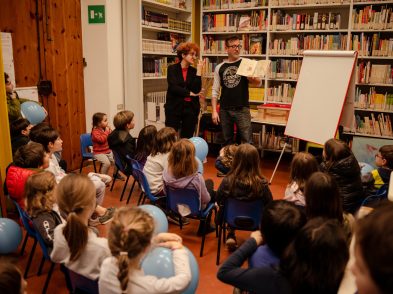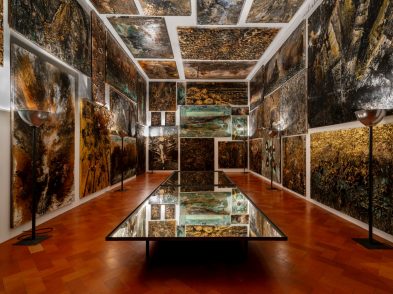For the first time, the three Pietàs (image of the Virgin Mary mourning the dead body of Christ) by Michelangelo are on display together in the Tribune Room at the Opera del Duomo Museum (piazza Duomo 9). The Three Pietàs of Michelangelo: No one thinks of how much blood it costs will be visitable from February 24 to August 1, 2022, opening to the public on the occasion of the ‘Mediterranean, Frontier of Peace 2022′ meeting that brings together the Bishops and Mayors of the Mediterranean.
The newly restored original Bandini Pietà (thanks to a contribution from Friends of Florence) and the casts of the Vatican Pietà and the Rondanini Pietà will be explored through a religious lens, with the title taking a quote from Dante’s Paradise XXIX, Non vi si pensa quanto sangue costa. The display offers the chance to study the evolution of Michelangelo’s art as well as his spiritual maturation. The three plaster casts of the original Pietà will be exhibited in the newly designed Sala delle Cariatidi of Palazzo Reale in Milan next autumn.
Curated by the museum directors Barbara Jatta (Vatican Museums), Sergio Risaliti (Museo Novecento), Claudio Salsi (Superintendent of the Castle Area, Archaeological Museum and Historical Museums) and Timothy Verdon (Opera del Duomo Museum), the project involves the Vatican Museums, Opera del Duomo Museum, Museo Novecento in Florence, Castello Sforzesco in Milan, Opera di Santa Maria del Fiore, the Municipality of Florence, Municipality of Milan and Fabbrica di San Pietro in a large-scale collaboration between Florence, Rome and Milan.

“The casts don’t look out of place next to the Florentine original”, explains Barbara Jatta, director of the Vatican Museums, “not only because they were carried out to perfection a few decades ago by masterful artisans, but above all because, in a time of much debate around NFT (Non-Fungible Token) and DOC.NFT (Digital Original Copy NFT) reproductions, they bear witness to the need for reproducing universal masterpieces of faith and art so they can be spread to a wider audience.”
Timothy Verdon, director of the Opera del Duomo Museum, commented on how the comparison between these three works “allows us to measure the stylistic growth of Buonarroti in the 50 years that separate the youthful Pietà from the other two…it also helps us to grasp the maturation of Michelangelo’s thoughts for the sacred subject between the late 15th century and the mid 16th century, focusing on the connection between life and art in the faithful sculptor who, for much of his career, was at the service of the popes and therefore a privileged interpreter of the demands of a Church in dynamic change”.
Vatican Pietà (1498-99)

Cardinal Jean Bilhèers de Lagraulas commissioned the young Buonarroti to depict “the Virgin Mary, dressed, with the Dead Christ naked in her arms”, completed close to the Jubilee of 1500. The Florentine sculptor devoted himself to the theme of maternal pain and to the mystery of the Incarnation, making an impression at the time for the beauty of the work, but also prompting criticism for portraying Mary as so youthful that it was deemed unsuitable. The masterpiece was placed in the chapel of Santa Petronilla shortly before 1500 and was later moved to St.Peter’s before being moved to the right of the nave in the 18th century, where it can still be admired today.
Bandini Pietà (from 1547)

From the time of the first Pietà to when Michelangelo next revisited the subject, Rome was sacked, the Republic of Florence collapsed and the Medici returned to the city. Michelangelo left Florence in 1534 and settled in Rome, becoming increasingly focused on human destiny, death and the resurrection of Christ. He began work on the marble block around 1547, but it was completed by his main assistant, Tiberio Calgani, before being sold to Francesco Bandini in 1561. Michelangelo intended that the work would be used for his own funerary monument in Santa Croce in Florence, but the work remained in the Bandini Villa in Montecavallo, and was purchased by Cosimo III de’ Medici in 1674, who had it placed in the basement of San Lorenzo. In 1722, the Florentine Pietà was transferred to Santa Maria del Fiore and it has been housed in the Opera del Duomo Museum since 1981.
Rondanini Pietà (1552-53)

Dating to 1552 and 1553, Michelangelo is said to have worked on this piece until the final days of his life. The work can be interpreted as the result of a long journey through art and faith that culminates in this ghostly representation of Jesus and Mary, with the two figures appearing almost detached from the ground and reaching upwards, seeming to reflect on the Resurrection and the Assumption. In 1744, the Pietà was purchased from the Marquis Giuseppe Rondinini and arrived in Milan, where it has been kept in Castello Sforzesco since 1952.








